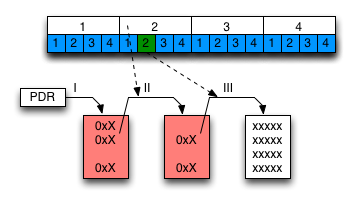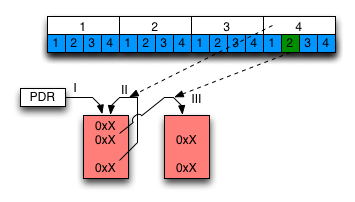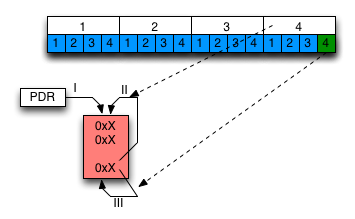Recursive Page Directory
26 Jun 2012
Memory management part 2
As discussed in Memory Page Stack one can divide memory management into three parts.
This post regards the second part, the Virtual Memory Manager (VMM).
Paging
In the x86 architecture, one normally uses a two-step paging algorithm.
In the previous post we imagined a computer with really really small memory pages. Now imagine that this computer has an even equally small virtual memory space - 16 pages in total. Those 16 pages are divided into four groups and this is our key to addressing them.

Above, we see the address space of our imagined computer illustrated as 16 blue squares. Let's say the processor wishes to access the sixth page and that paging is enabled. The sixth page belongs to the second group of pages and is the second page in that group.
Now the Memory Management Unit (MMU) of the processor kicks in and takes a look in a certain processor register. This register contains the (physical) address of the Page Directory (step I). Since we want the second group, it reads the second entry from the page directory and this gives the physical address of a page table (step II). We want the second page in that group, so the MMU reads the second entry in the page table and this gives the physical address of the memory page we want (step III).
What makes paging so great is that the whole process is completely transparent to the processor. The user will never know when a memory read or write operation crosses a page boundary, and by changing the entries in the page directory and tables you can get a contiguous memory area anywhere in the virtual address space without having to worry about fragmentation of the physical memory.
Recursive page directory
Paging lets you easily decide what parts of memory the processor has access to and it can be dynamically changed by changing the contents of the page directory and page tables. Of course, that requires you to keep track of where those are, but a neat little trick makes that really easy.
The trick consists of setting the last entry in the page directory to point to the page directory itself.
Let's say we did this, and that the processor wishes to access the 14th page in virtual memory - that is the second page in the fourth group. The MMU starts by looking up the fourth group in the page directory. It finds the address of the page directory and assumes this is the page table for the group. It caries on, looking up the second entry in this 'page table' and gets the address of the page it wants. This happens to be the address of the page table for the second group.

In other words, you can access any page table through a fixed address in memory. But wait, it gets even better.
Let's look at what happens if we try to access the very last page in the virtual memory. The MMU will look up the last entry in the page directory and get the address of the page directory. It will then look up the last entry in the page directory and get the address of the page directory (that's not a typo - I meant to write the same thing twice). This lets you access the page directory too through a fixed memory address.

Some considerations
An important question to put at this point is whether a recursive page directory is really a good idea.
In our imaginary computer with its really small address space, we notice that the page table and directories now reserve a quarter of the entire available virtual memory - which is of course incredibly wasteful. On a computer with a 32 bit address bus the reserved area would be 1/1024 th of the available address space, though, which is more reasonable. Then again, if your computer has 4 gigabytes of physical RAM, this would mean there is four megabytes of it that can't be used. Then again again, if you have easy access to your page tables - such as through a recursive page directory - you can just page in those 4 megabytes as needed.
There are other simple ways of accessing the page directory and tables. For example, if you just keep track of the page directory and one page table it's a simple job to page in another table anywhere and read it.
The recursive page directory divides the OsDev community. I think it's a nice tool, others don't.
The addresses
Finally, if a recursive page directory is used on an x86, the following can be used to access the page directories and tables:
uint32_t *page_dir = 0xFFFFF000; uint32_t *page_tables = 0xFFC00000; //addr = virtual address //phys = physical address (page alligned) //flags = access flags //ptab = physical address of space allocated for a page table (1 page) page_dir[addr >> 22] = ptab | flags; page_tables[addr >> 12] = phys | flags;
Git
A recursive page directory has been implemented in Git commit caed8cb8a0. Also implemented in the same commit is a physical memory manager with a free page stack described in this post